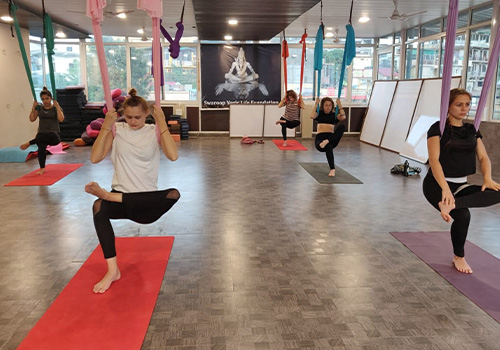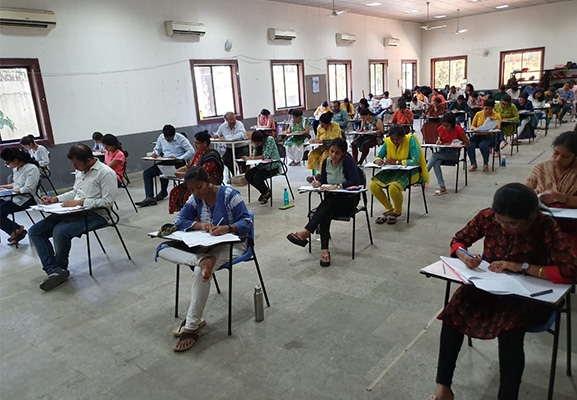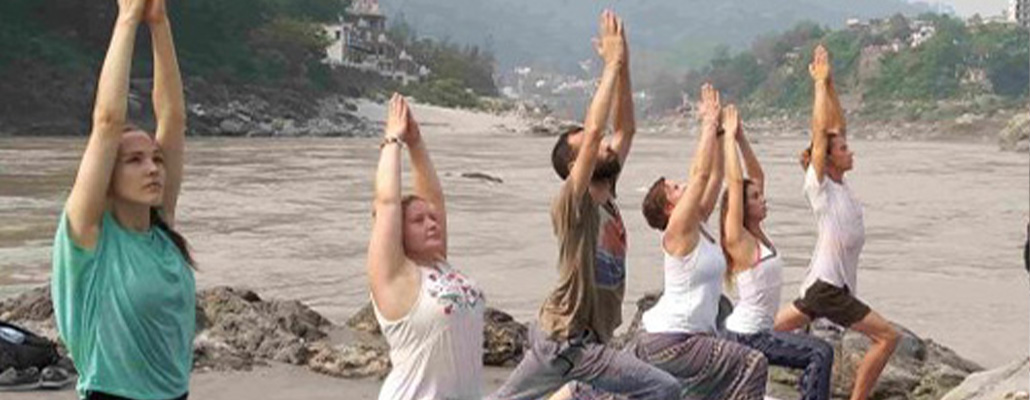300-Hour Yoga TTC, Ananda Yoga And Wellness Center Rishikesh
300-hour Yoga Teacher Training Course, Rishikesh certified by Yoga Alliance USA or World Yoga Alliance, is a High-level YTTC program, based on the aspects of a 200-hour YTTC program, which extends your comprehension and practices. The 300-hour Yoga Teacher Training Course in Rishikesh, India, teaches you how to identify yoga's goals and techniques, which are much more advanced than the 200-hour TTC.

300-Hour Yoga TTC, Rishikesh Outcomes
- Advanced Asanas, Pranayama, Meditation, Bandhas, Mudras, and Yoga Kriyas.
- How to teach Yoga to advanced practitioners.
- Comprehensive study of advanced aspects of Yoga Philosophy, Meditation, and Yogic Lifestyle.
- Extensive study of body Anatomy and Physiology, and how that knowledge can be used in our Yoga Practice.
- You would learn the Yoga Anatomy, Energy Anatomy, and Tantra Anatomy, in detail.
- Study of authentic Yoga Textbooks: Patanjali Yoga Sutra, Bhagwad Gita, Hatha Yoga Pradipika.
- How to practice Yoga on the mat as well as off the mat.
- Practicum: a training of teaching the students, under the supervision of our lead trainers.
300-hour yoga teacher training Syllabus And Curriculum
There is currently a significant amount of misinformation regarding the practices of yoga. Yoga philosophy must directly reference the treatises to connect to tradition. This Programme will develop comprehension and appreciation of Yoga among students. Yoga philosophy takes a holistic approach to life. It incorporates self-realization and exploration of true nature. The yogic texts listed below make up the 300-hour philosophy:
The yoga sutra of Patanjali:
In the Yoga Sutras, Patanjali provides an extremely scientific and practical explanation of yoga’s philosophy and practice. The Eight Appendages of Yoga, otherwise called Ashtanga yoga, is portrayed in a vital segment of the book, and it offers reasonable rules for achieving an ultimate state of consciousness. The segments from the 200-hour yoga TTC will be retold in the form of a discourse, which will discuss the final two chapters and go into detail about the important sutras.
Hatha yoga Pradipika
Yogi Swatmarama wrote this excellent book on Hatha Yoga. The instructions in the text are extremely helpful for understanding the body's mechanics and directing the energies in a harmonious direction. By re-establishing equilibrium between the sun (Ha) and the moon (Tha), one can prepare for a higher possibility. A portion of the subjects are as per the following:
- Presentation Of Yoga
- Significance of Hatha yoga
- Hatha Yogi ancestry
- Significance of Hatha Yoga
- Disastrous and productive parts of yoga
- Techniques for Hatha Yoga Practice and Yogic eating routine
- Relationship between Hatha yoga and Raja yoga
Gheranda Samhita
Two of India's oldest primary Hatha Yoga texts are the Gheranda Samhita and the Hatha yoga Pradipika. They have been the study of the therapeutic aspect of Hatha Yoga for several years. Ghata yoga is the name given to the Hatha yoga practices in the Gheranda Samhita. In this version, the human body is compared to a dirt pot, and the practices of Hatha yoga are compared to how one shapes the mud, seals the gaps in the wet mud, and cements the pot through one's focused practice. A portion of the subjects are as per the following
- An overview of the Gheranda Samhita
- The seven steps of Ghata yoga
- The advantages of Ghata yoga
- Methods of purification
- The classification of asanas and their advantages
- A comparison of Hatha yoga and Ghata yoga.
Upanishad
The insights gained by the Yogis are referred to as the Upanishads, defined as "to sit with oneself" or "to sit in the presence of the master." Wisdom as a means of liberation is discussed in these Sessions. This is the end part of the Vedas, and the subject of yoga is introduced in a conversational structure. The Upanishad’s discussion of yoga is very easy to understand. During the study of the Upanishads, the difference between real and unreal is revealed. Concentrating on the Upanishads assists the expert with executing yoga in their day-to-day routines. The self-inquiry, "Ko Ham?" is sparked by an examination of the Upanishads.
The 300-hour Advanced Yoga Teacher Training in Spiritual Anatomy and Physiology
It teaches a thorough understanding of the anatomy and physiology of the human organ systems that are essential to one's yogic practice. It also discusses the connection between human anatomy, physiology, chakra, and kosha. Also discussed is the connection between the psycho-philosophical nature of the human organ systems and their physiology.
Solid Framework
Ligaments and tendons, muscle classification, histology, properties, distribution, muscle contraction mechanism, and neuromuscular transmission
Skeletal Framework
Types of bones, their structure and function, joints, the spine, and restrictions at the end field
The Immune and Lymphatic Systems
The lymphatic system's functions, major and accessory organs (lymph, lymph nodes, spleen, tonsils, thymus, and capillaries), and blood corpuscles' composition (platelets, red blood cells, and white blood cells). Plasma, lymph, haemoglobin, blood coagulation and anticoagulants, blood groups and their significance, the lymphatic system, types of immunity, and the immune system's mechanism relationship between pranamaya kosha and the lymphatic system.
Cardiovascular framework
Major and accessory organs of the cardiovascular system (the heart, blood vessels—veins, arteries). Control of the cardiac cycle and circulation, cardiac output, blood pressure, and heart rate, as well as the properties of cardiac muscle The cardiovascular system's connection to the annamaya kosha.
The System of Breathing
Major organs of the respiratory system (nasal cavity, trachea, lungs, bronchioles, bronchiole trees, alveolar sacs, diaphragm, and muscles in the chest, shoulders, and back) Breathing's mechanism, gas exchange, pulmonary function tests, lung volume, and breathing control Relationship of respiratory framework to annamaya kosha.
Organs of digestion
Major and accessory organs of the digestive system (the mouth, salivary glands, tongue, oesophagus, stomach, pancreas, liver, gall bladder, and small and large intestines). Gastric juice, bile, intestinal secretions, enzymes from the pancreas, and saliva. The function of these secretions is in food digestion, nutrient absorption and assimilation, and faeces excretion. The connection between the digestive system and the annamaya kosha.
The Hormonal System
Major and accessory organs of the endocrine system (thyroid, parathyroid, hypothalamus, thalamus, adrenal glands, hippocampus, pituitary gland, and reproductive glands) perform their functions. The hormones produced by these glands and how they affect the body's hypoactivity and hyperactivity. Role of insulin in the metabolism of glucose. Relationship of endocrine framework to manomaya kosha.
System of Nerves
Major and accessory organs of the nervous system (the brain, spinal column, cranial nerves, and spinal nerves). Gross life structures of the cerebrum: spinal cord, cerebellum, and cerebellum. Physiology and significant associations of the frontal cortex, pons, medulla, thalamus, nerve center pineal organ, pituitary organ, and cerebellum. Physiology of Substantial Sensory System and Autonomic Sensory System: Nervous System (Parasympathetic and Sympathetic).Manomayaa kosha and the nervous system's connection.
Method of reproduction
All of an organism's anatomical organs involved in amphimixis are made by the genital system, also known as the reproductive system. Numerous non-living substances, such as fluids, hormones, and pheromones, are crucial components of the organs engaged with creating posterity. This method involves the ovaries, fallopian tubes, uterus, cervix, and vagina in women. It includes the penis, testicles, and prostate in men.
Mantra Educational programme
The reverberating sound of Mantras calms the body and mind. A mantra is a word or sound that is repeated during meditation to aid in concentration. Mantras are practiced psalms that help in expanding the reflective and viable parts of Yoga. At Ananda Yoga And Wellness Center, the 300-hour yoga TTC helps students in encountering serene vibrations and making a tranquil climate
- Ganesha Mantra
- Guru Mantra
- Shakti Mantra
- Gayatri Mantra
- Mangalacharan Mantra
- Shanti Mantra
300-Hour TTC Yoga Philosophy:
Modification techniques, teaching a variety of meditation techniques, organizing and preparing for a workshop, and principles of demonstration, observation, alignment, and correction are all included.

300 Hours Yoga Asana and Pranayama Practice Sessions
Cleansing practices
- Kapalbhati
- Neti
- Tratak
Dynamic Yoga postures
- Pawanmuktasana series
- Marjari asana
- Vyaghrasana
- Surya Namaskar
Standing Yoga postures
- Tadasana
- Utkatasana
- Padhastasana
- Trikonasana
- Parivrtta Trikonasana
- Parshwakonasana
- Parivrtta parshwakonasana
- Veerbhadrasana I
- Veerbhadrasana II
- Veerbhadrasana III
- Ardh chandrasana
- Parsvottanasana
- Prasarita padottanasana
Inverted Yoga postures
- Sirsasana
- Sarvangasana
- Halasana
- Pincha mayurasana
- Adho mukha vrkshasana
Backbend Yoga postures
- Bhujangasana
- Shalabhasana
- Dhanurasana
- Matsyasana
- Ushtrasana
- Kandhrasana
- Chakrasana
- Gomukhasana
- Setu asana
- Rajkapotasana
Forward bend Yoga postures
- Paschimotanasana
- Janusirasana
- Ardh padam paschimotanasana
- Padprasar paschimotanasana
- Adho mukha svanasana
Twisting Yoga postures
- Ardh matsyendra asana
- Parivritti janu sirshasana
- Kati chakrasana
Balancing Yoga postures
- Vrkshasana
- Bak dhayan asana
- Mayurasana
- Natraj asana
- Garudasana
Relaxation Yoga postures
- Shashankasana
- Makarasana
- Savasana
Breathing Yoga postures
- Yogic Breathing
- Nadi shodhan
- Kapalbhati
- Bhastrika
- Ujjayi
- Bhramari
Meditative Yoga postures
- Sukhasana
- Padamasana
- Vajrasana
Meditational Yoga postures
- Breath awareness
- Tratak
- Yog Nidra
- Mantra chanting
- Yantra drawing
Yog Mudras
- Anjali Mudra
- Chin Mudra
- Jnana Mudra
- Poorna Mudra
